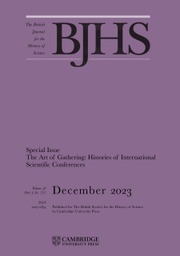Andrew Hogan’s Disability Dialogues is a rarity: a history of medicine that centres disability. Long-standing conceptual and political barriers have stood between the history of medicine and disability history, but, as Beth Linker argued over a decade ago (‘On the borderland of medical and disability history’, Bulletin of the History of Medicine (2013) 87(4)), dialogue between them has the potential to be transformative. After all, disability historians have a powerful vantage point for revealing medicine’s otherwise invisible structures, prejudices and practices, and historians of medicine and science are well placed to bring into view the constructed nature of medical ‘reality’. A dazzling array of scholars – such as Jaipreet Virdi, Viktoria Tkaczyk, Wei Yu Wayne Tan, Marion Schmidt, Sarah F. Rose, Mara Mills, Coreen McGuire and Andrew Hogan, among others – are engaging in such dialogue to show how disability can be understood as a source of expertise, and how science and medicine can be positioned as part of the historical social landscape that produces disability.
Disability Dialogues is an important contribution to this new scholarship. Focusing on professional medicine in the United States, Hogan takes ‘disability’ as a vantage point from which to chart the changing professional authority, expertise and prestige of three postwar fields of clinical practice – paediatrics, clinical psychology and genetic counselling. Readable and carefully researched, the book combines a sociological interest in the professional dynamics of these fields with attention to powerful biographical stories, especially of professionals with first-hand experience and knowledge of impairment and the disabling effects of society. Hogan’s close attention to professional self-advocates working within clinical disciplines avoids assuming opposition between disability advocates and clinical professionals. The result is a detailed account of how medical professionals (both abled and disabled) worked with and against the category of ‘disability’, and how they used it to develop areas of authority and prestige.
The organization of the book is unusual, but it captures a complex terrain. Part One focuses on the internal professional politics of (in turn) post-war paediatrics, clinical psychology and genetic counselling. Part Two takes another look at those same fields, zooming in on case studies and biographies of a small numbers of disability advocates, including self-advocates, who advanced more positive, inclusive and sociopolitical perspectives on disability in their specialist fields. This second half contains some of the book’s most compelling sections, which draw extensively on a wide range of interviews between Hogan and individual professionals, and recount in moving detail the attempts of groundbreaking individuals to change professional structures and the views of colleagues.
Hogan says little about why he chose to focus on the three fields in question, but usefully that choice focuses attention on adults (clinical psychology), children (paediatrics) and prospective parents (genetic counselling) and thereby varied forms of advocacy and constructions of disability. Hogan asks, when and why did professionals in these fields claim expertise and authority over specific forms of impairment? How were practices shaped by individual (self-)advocates working within the ranks of professional medicine? Where, when and to what extent did health professionals treat disabled clinicians and patients as sources of insight into medical knowledge, training and practices? Adopting a sociological interest in ‘jurisdictions’ – the way in which professional groups claimed control and expertise over specific conditions, particular patient populations or kinds of clinical service – Hogan points to the varied ways in which concerns about disciplinary identity and prestige (that is, markers of status that might be gained by individual professionals) intersected with concepts of disability (also raising questions in my own mind as to how these further intersected with gender and ‘race’). Although it is hard to generalize broad themes across the disciplines considered, Hogan makes it abundantly clear that for each field, dynamic and influential (self-)advocates did powerful work to shift colleagues’ views to more inclusive, positive views of disability, but that change was often limited by professional and structural barriers.
The fine-grained character of this account makes it a rich and important scholarly contribution to the history of medicine that researchers will have to engage with, although its level of detail may make it a more challenging read for undergraduates and broader audiences. Nevertheless, the specificities of the book are among its strengths; after all, ‘disability’ is a highly varied category that brings into view a multidimensional landscape of experiences that cannot be reduced and generalized. Indeed, the book is a tremendously welcome prompt to historians of medicine to think about the diversity of ways in which disability experiences and perspectives were incorporated (or not) beyond the United States in other health care systems and medical contexts. It would also be fascinating to learn more about how practices in the highly specialist spaces of clinics were tied to the broader social, political and legal norms that shaped the lives of people with impairments – as Hogan points out, it is clinicians who have often played key roles in adjudicating those norms. Overall, this book affirms Catherine Kudlick’s argument (‘Social history of medicine and disability history’, in The Oxford Handbook of Disability History (2018)) that ‘disability’ in history has the potential to reveal much about the politics, epistemologies, economics and cultures of medicine.



